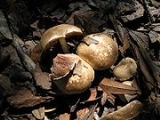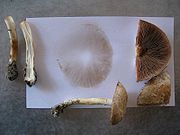
Agaricus semotus
Encyclopedia
Agaricus semotus is a woodland mushroom of the Agaricales
order
of fungi. It, like many of its relatives, can be found spread throughout wooded, moist areas in the southern United States, and has been found in areas ranging from California
to Florida
; it is also indigenous to Great Britain
and Europe
. A. semotus has also been collected in New Zealand
. Although various authors disagree about its edibility, its modest size prevents it from being a significant source of nutrition.
is 2–7 cm in diameter, initially convex while flattening with age; it typically has a low umbo–a raised, conical mound in the center of the cap. The surface color can range from a lighter cream to a darker tan, with brownish scales thinning out towards the margin of the cap. The gills are free from the stalk and packed closely together, showing a pink to salmon color in youth and aging to a darker brown. The stalk
The stalk
is 3–7 cm tall and 0.4–0.8 cm broad, and bruises yellow when handled. A ring
or remnants thereof are often evident, while the partial veil
is often absent or minutely visible along the margin of the cap
. The flesh
is white throughout and stains yellow when bruised. The spore print
is dark brown
.
The taste is said to be slightly reminiscent of anise or almond while the odor is often more distinctive.
The spore
s are 4.5–5.5 x 3–3.5 µm
, smooth, nonamyloid
, and elliptical. The basidia, the spore-bearing cells, are 4-spored, while the cystidia (relatively large non-spore producing cells typically found on the hymenium
) are roughly club-shaped with thin walls.
. This clade also includes the species A. silvicola
, A. arvensis
and A. abruptibulbus
; these species also bruise yellow, and smell of almonds.
Agaricales
The fungal order Agaricales, also known as gilled mushrooms , or euagarics, contains some of the most familiar types of mushrooms. The order has 33 extant families, 413 genera, and over 13000 described species, along with five extinct genera known only from the fossil record...
order
Order (biology)
In scientific classification used in biology, the order is# a taxonomic rank used in the classification of organisms. Other well-known ranks are life, domain, kingdom, phylum, class, family, genus, and species, with order fitting in between class and family...
of fungi. It, like many of its relatives, can be found spread throughout wooded, moist areas in the southern United States, and has been found in areas ranging from California
California
California is a state located on the West Coast of the United States. It is by far the most populous U.S. state, and the third-largest by land area...
to Florida
Florida
Florida is a state in the southeastern United States, located on the nation's Atlantic and Gulf coasts. It is bordered to the west by the Gulf of Mexico, to the north by Alabama and Georgia and to the east by the Atlantic Ocean. With a population of 18,801,310 as measured by the 2010 census, it...
; it is also indigenous to Great Britain
Great Britain
Great Britain or Britain is an island situated to the northwest of Continental Europe. It is the ninth largest island in the world, and the largest European island, as well as the largest of the British Isles...
and Europe
Europe
Europe is, by convention, one of the world's seven continents. Comprising the westernmost peninsula of Eurasia, Europe is generally 'divided' from Asia to its east by the watershed divides of the Ural and Caucasus Mountains, the Ural River, the Caspian and Black Seas, and the waterways connecting...
. A. semotus has also been collected in New Zealand
New Zealand
New Zealand is an island country in the south-western Pacific Ocean comprising two main landmasses and numerous smaller islands. The country is situated some east of Australia across the Tasman Sea, and roughly south of the Pacific island nations of New Caledonia, Fiji, and Tonga...
. Although various authors disagree about its edibility, its modest size prevents it from being a significant source of nutrition.
Description
The capPileus (mycology)
The pileus is the technical name for the cap, or cap-like part, of a basidiocarp or ascocarp that supports a spore-bearing surface, the hymenium. The hymenium may consist of lamellae, tubes, or teeth, on the underside of the pileus...
is 2–7 cm in diameter, initially convex while flattening with age; it typically has a low umbo–a raised, conical mound in the center of the cap. The surface color can range from a lighter cream to a darker tan, with brownish scales thinning out towards the margin of the cap. The gills are free from the stalk and packed closely together, showing a pink to salmon color in youth and aging to a darker brown.

Stipe (mycology)
thumb|150px|right|Diagram of a [[basidiomycete]] stipe with an [[annulus |annulus]] and [[volva |volva]]In mycology a stipe refers to the stem or stalk-like feature supporting the cap of a mushroom. Like all tissues of the mushroom other than the hymenium, the stipe is composed of sterile hyphal...
is 3–7 cm tall and 0.4–0.8 cm broad, and bruises yellow when handled. A ring
Annulus (mycology)
An annulus is the ring like structure sometimes found on the stipe of some species of mushrooms. The annulus represents the remaining part of the partial veil, after it has ruptured to expose the gills or other spore-producing surface. An annulus may be thick and membranous, or it may be cobweb-like...
or remnants thereof are often evident, while the partial veil
Partial veil
thumb|150px|right|Developmental stages of [[Agaricus campestris]] showing the role and evolution of a partial veilPartial veil is a mycological term used to describe a temporary structure of tissue found on the fruiting bodies of some basidiomycete fungi, typically agarics...
is often absent or minutely visible along the margin of the cap
Pileus (mycology)
The pileus is the technical name for the cap, or cap-like part, of a basidiocarp or ascocarp that supports a spore-bearing surface, the hymenium. The hymenium may consist of lamellae, tubes, or teeth, on the underside of the pileus...
. The flesh
Trama (mycology)
In mycology trama is a term for the inner, fleshy portion of a mushroom's basidiocarp, or fruit body. It is distinct from the outer layer of tissue, known as the pileipellis or cuticle, and from the spore-bearing tissue layer known as the hymenium....
is white throughout and stains yellow when bruised. The spore print
Spore print
thumb|300px|right|Making a spore print of the mushroom Volvariella volvacea shown in composite: mushroom cap laid on white and dark paper; cap removed after 24 hours showing pinkish-tan spore print...
is dark brown
Brown
Brown is a color term, denoting a range of composite colors produced by a mixture of orange, red, rose, or yellow with black or gray. The term is from Old English brún, in origin for any dusky or dark shade of color....
.
The taste is said to be slightly reminiscent of anise or almond while the odor is often more distinctive.
The spore
Spore
In biology, a spore is a reproductive structure that is adapted for dispersal and surviving for extended periods of time in unfavorable conditions. Spores form part of the life cycles of many bacteria, plants, algae, fungi and some protozoa. According to scientist Dr...
s are 4.5–5.5 x 3–3.5 µm
Micrometer
A micrometer , sometimes known as a micrometer screw gauge, is a device incorporating a calibrated screw used widely for precise measurement of small distances in mechanical engineering and machining as well as most mechanical trades, along with other metrological instruments such as dial, vernier,...
, smooth, nonamyloid
Amyloid
Amyloids are insoluble fibrous protein aggregates sharing specific structural traits. Abnormal accumulation of amyloid in organs may lead to amyloidosis, and may play a role in various neurodegenerative diseases.-Definition:...
, and elliptical. The basidia, the spore-bearing cells, are 4-spored, while the cystidia (relatively large non-spore producing cells typically found on the hymenium
Hymenium
The hymenium is the tissue layer on the hymenophore of a fungal fruiting body where the cells develop into basidia or asci, which produce spores. In some species all of the cells of the hymenium develop into basidia or asci, while in others some cells develop into sterile cells called cystidia or...
) are roughly club-shaped with thin walls.
Edibility
It has been reported as edible, but others claim that it may cause gastrointestinal discomfort. Arora notes that these mushrooms are "rarely collected because of their small size."Phylogenetics
Phylogenetic analysis suggests that A. semotus belongs in a group of closely related species within the Agaricus genus, known as the Arvensis cladeClade
A clade is a group consisting of a species and all its descendants. In the terms of biological systematics, a clade is a single "branch" on the "tree of life". The idea that such a "natural group" of organisms should be grouped together and given a taxonomic name is central to biological...
. This clade also includes the species A. silvicola
Agaricus silvicola
Agaricus silvicola, also known as the Wood Mushroom is a species of Agaricus mushroom related to the button mushroom.- Description :...
, A. arvensis
Agaricus arvensis
Agaricus arvensis, commonly known as the Horse Mushroom, is a mushroom of the genus Agaricus.-Taxonomy:Described as Agaricus arvensis by Jacob Christian Schaeffer in 1762, and given numerous binomial descriptions since. Its present name arvensis means 'of the field'.-Description:The cap is similar...
and A. abruptibulbus
Agaricus abruptibulbus
Agaricus abruptibulbus is a species of mushroom in the genus Agaricus. It is commonly known as the abruptly-bulbous agaricus or the flat-bulb mushroom. First described by the mycologist Charles Horton Peck, this bulbous-stemmed edible species smells slightly of anise, and turns yellow when bruised...
; these species also bruise yellow, and smell of almonds.

